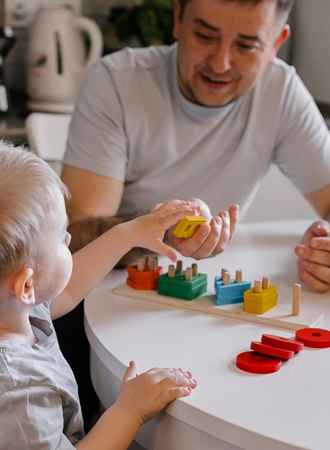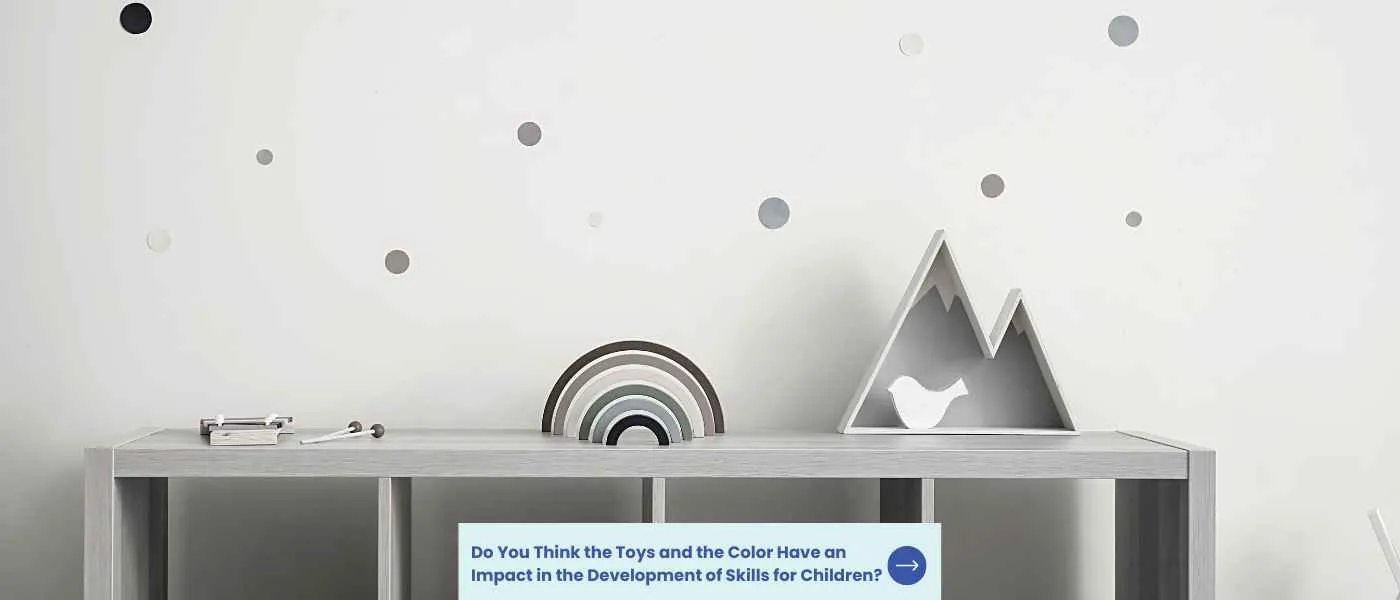Toys and colors are an essential part of childhood, and as children grow, they interact with various toys and colors, which play a crucial role in their development. Toys and colors are not only fun and entertaining but also have a significant impact on children’s cognitive, emotional, and social development.
Many studies have shown that the type of toys and colors children interact with can significantly affect their skill development. Therefore, it’s essential for parents, educators, and caregivers to understand the impact of toys and colors on children’s development to provide them with the best opportunities to develop their skills.
In this blog post, we’ll explore the impact of toys and colors on the development of skills for children and discuss how parents and caregivers can use this knowledge to help children thrive.
Key Takeaways on the Impact of Colorful Toys on Child Development
- The impact of color on children’s developmental skills is undeniable, and it can be used to create positive learning experiences for children.
- Educational toys are essential for helping children develop attention and focus, problem-solving skills, gross motor skills, hand-eye coordination and creativity.
- Every child is unique and may have different preferences for colors and their environment. Pay attention to your child’s likes and dislikes and incorporate colors in a way that works for them.
Toys and colors play an influential role in children’s development. They are not only sources of entertainment but also tools that contribute to a multitude of developmental areas
| Aspect of Development | Impact of Toys | Impact of Colors |
|---|---|---|
| Cognitive Development | – Problem Solving: Toys like puzzles and building blocks challenge children’s thinking and improve problem-solving skills. – Cause and Effect: Toys that respond to a child’s action (e.g., a toy car that moves when pushed) help children understand cause and effect. | – Color Recognition: Identifying and naming colors enhances cognitive skills and vocabulary. – Categorization: Grouping toys or objects by color fosters logical thinking and categorization skills. |
| Motor Skills Development | – Fine Motor Skills: Toys that require precision, like threading beads or stacking blocks, develop fine motor skills. – Gross Motor Skills: Larger toys like ride-ons or ball games promote gross motor skills and coordination. | – Visual Tracking: Bright colors can capture a child’s attention, aiding in visual tracking and focus. – Hand-Eye Coordination: Coloring or sorting toys by color can enhance hand-eye coordination. |
| Social & Emotional Growth | – Role Play & Empathy: Dolls or action figures allow children to role-play and understand emotions, fostering empathy. – Sharing & Cooperation: Playing with toys in a group setting teaches children about sharing, taking turns, and cooperation. | – Mood & Emotion: Colors can evoke specific moods and emotions. For instance, blue is calming, while red can be energizing. Recognizing these associations can aid in emotional awareness. – Self-Expression: Choosing colors for art projects allows children to express themselves. |
| Language Development | – Vocabulary Growth: Playing with various toys introduces children to new words and concepts, expanding their vocabulary. – Narrative Skills: Role-playing with toys can enhance narrative and storytelling skills. | – Descriptive Language: Describing colors and their nuances (e.g., light blue vs. dark blue) refines language skills. – Communication: Discussing color preferences or describing objects based on color aids in communication skills. |
| Creativity & Imagination | – Open-Ended Play: Toys without a fixed purpose (e.g., building blocks) encourage open-ended play and creativity. – Scenario Creation: Toys like playsets or action figures allow children to create scenarios, boosting imagination. | – Artistic Expression: Colors are integral to art and creativity. Mixing colors, painting, or drawing allows children to explore their artistic side. – Imagination: Imagining scenarios based on color (e.g., a yellow sun, a blue ocean) fosters imaginative thinking. |
The toys children play with and the colors they’re exposed to significantly shape their learning experiences. By providing a diverse range of toys and introducing a broad spectrum of colors, caregivers can ensure a holistic developmental environment for children.
The Impact of Color on Developmental Skills
Colors can have a powerful impact on children’s development, from cognitive skills to emotional and social growth. It is important for parents to understand how different colors can influence their child’s learning and behavior in order to create an environment that encourages positive development.
Cognitive Development
Color has been found to stimulate the developing brain, allowing it to process information more quickly and accurately. Studies have shown that certain colors can help improve memory recall, increase concentration levels, and boost problem-solving abilities. For example, research suggests that red may be beneficial for math related tasks while blue could be helpful with language based activities.
Emotional Development
Colors also play an important role in helping children develop emotionally and gain understanding on how the world around them works. Bright colors like yellow or orange are often associated with happiness while darker shades such as purple or black are thought of as calming influences. By using color strategically in the home or classroom setting you can help your child feel secure and comfortable which will allow them to better express themselves without fear of judgement or criticism.

Social Development
Colors not only affect our emotions but they also shape our interactions with others around us by creating a sense of connection between people who share similar hues or patterns in their clothing choices for instance . Additionally , studies suggest that lighter colored rooms tend to promote conversation among individuals whereas darker tones foster feelings of privacy . Therefore , when decorating a space where children will interact it is important consider what type of atmosphere you want them experience .
What Are Some Ways to Incorporate Colors Into a Child’s Environment?
Here are some ways to incorporate colors into a child’s routine:
- Painting the walls of a child’s room or play area can be a great way to incorporate color into their environment. Consider using bright, stimulating colors like yellow or red, or calming colors like blue or green.
- Colorful bedding can add a pop of color to the room of your toddler or baby and can be easily changed as the child grows and their tastes change.
- Hanging colorful artwork on the walls, such as paintings or posters, can add visual interest and brighten up a room.
- Playing with colorful toys can engage child’s senses and can be a source of entertainment and stimulation. Consider choosing toys with a variety of colors and shapes.
- Reading books with colorful illustrations can help with a child’s development and literacy skills. Consider choosing books with bright and engaging illustrations.
- Using colorful storage bins can help keep a child’s toys and belongings organized while also adding a pop of color to their room.
- Incorporating natural elements like plants or flowers can add color to a child’s environment while also providing a calming and soothing atmosphere.

What Are the Best Ways to Teach Colors to a Young Child?
Children learn through play and introducing them to the world of colors can be a fun and engaging experience. Here are some effective ways to teach children about colors:
- Provide your child with toys and particular objects of different colors such as blocks, balls, crayons, and puzzles based on age range. Encourage your child to name the colors of the objects and ask them to sort the objects by color.
- Reading books with colorful illustrations is a great way to introduce colors to young children. Point out the colors in the pictures and ask your child to name them. It also helps with language development and build cognitive abilities.
- Play games with big kids that involve colors, such as “I Spy” or “Color Hunt.” In “I Spy,” you can say, “I spy something that is blue,” and your child can try to guess what it is. In “Color Hunt,” you can give your child a list of colors and ask them to find objects of those colors.
- Sing songs and recite rhymes that involve colors, such as “The Rainbow Song” or “Red, Red, Red.” This can help your child remember the names of different contrasting colors.
- Point out the colors of objects around your home or when you are out and about with your child. For example, you can say, “Look at the red car!” or “This banana is yellow.”
Remember to keep the activities fun and playful, and don’t worry too much about your child being able to name every color correctly. The goal is to introduce them to the concept of colors and have fun learning together.
For those who are still uncertain about the influence of toys and colors on a child’s development, a common question that arises is whether investing in educational toys and media for infants is worth the effort.
The Importance of Toys in Developing Attention and Focus
Children love toys and toys are essential for helping them develop fine motor skills, attention and focus at a young age and during different developmental stages.
Open-ended play can enhance learning and encourages children to explore and experiment, giving them the opportunity to practice self-regulation and decision making. Through open-ended play, children can learn how to think critically and solve problems on their own.
Structured activities such as shape sorters, puzzles, building blocks and other toys promote development of motor skills while also developing a sense of orderliness that helps build attention span. Imagination is key when it comes to toys. Imaginative play helps a child learn to create stories, act out scenarios, and express themselves in ways that they may not be able to do otherwise.
Open-ended play with the right toys is an important part of developing attention span in children because it requires them to make decisions independently without relying on someone else’s instructions or guidance. This type of activity teaches kids new skills and how to think creatively and use problem solving strategies like trial and error or experimentation in order to reach a solution.
Open ended toys such as musical instruments, wooden blocks or magnetic tiles provide endless possibilities for creative exploration which keeps kids engaged for longer periods of time than structured activities would allow them too.
Structured activities like puzzles are great tools for teaching patience since completing one requires sustained concentration over a period of time until all the pieces fit together correctly — this helps build up the child’s ability to stay focused even when faced with difficult tasks or challenges later on in life.
Building blocks also offer similar benefits but require more physical coordination from the child since they must manipulate each piece into place using both hands simultaneously — this develops fine motor skills while also strengthening hand eye coordination at the same time!
Imagination plays an important role when it comes toy selection. Look for toys that encourage pretend play so your child can explore different roles through acting out stories or scenarios with dolls, action figures and vehicles.
Pretend play involving toys such as play kitchens offer positive learning experience for babies and toddlers. It also gives your little girl or boy the freedom express themselves without any boundaries which boosts confidence levels while allowing them practice social interaction within safe parameters set by parents/caregivers if needed.
It’s also beneficial because it helps foster creativity by providing opportunities where new ideas can be explored freely without judgement from others – something every kid needs growing up.






